
 |
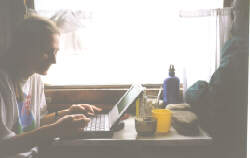
|
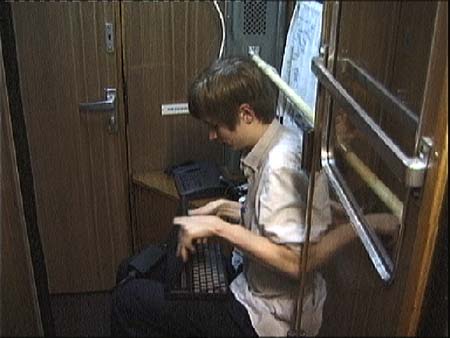
|
| Zuzanna using a notebook computer on the train, and Oras charging up his computer battery using the shaver socket at the end of the corridor. |
For most of us the journey spanned two continents, and few had made such a long journey overland before. This chapter tries to get across our vivid impressions of the journey, and also to describe what life was like on the trains, boats and bicycles, and in the temple in Japan. We also held meetings and conferences with local people on the journey, but these will be described in detail in the next chapter. Our workshops on the way are discussed at the end of this chapter.
Although it may seem "exotic" to west Europeans to travel so far on a train, for many Russians and Chinese it is still the normal way to get about their vast countries. People who have only ever travelled in cramped and spartan west-European trains with endless rows of seats or cramped couchettes, may wonder how we could survive for up to six days continuously on one train without becoming restless and bored. In Russian trains each person has much more space, you can lie down and spread your bags, and it is normal to chat with strangers and share your food with them, even to play a little music. We also arranged many workshops, and all felt very busy, certainly never bored. Sometimes we wished we had a little more time just to watch the ever-changing scenery go by.
In contrast, on the modern Eurostar which began our journey from London under the channel tunnel it was hard to feel comfortable chatting in a group, even long enough to share a bottle of champagne to celebrate our departure. It was hard to believe, after so much planning, that we were on our way at last. We relaxed for a couple of hours in a restaurant in Brussels before continuing on the overnight train to Berlin. Our meetings in Berlin and the next day in Warsaw are described in the next chapter, and since we only travelled by night we remembered little of this stage of the journey.
On trains across Russia
Our first unforgettable experience of Russia was on the restaurant car which was attached to the Polish train at the border of Belarus . A few of us went there to chat in the evening. The restaurant manager had removed some of the tables and was playing lively Russian pop songs on an old tape deck, to which some young couples were dancing, aided both by copious quantities of vodka and the irregular swaying of the train from side to side as it rattled through the dark swamps and forests of Belarus. One couple even did a striptease dance on top of one of the tables, to much applause! Every Russian restaurant car had its own unique style and special atmosphere, but the food was expensive and not in itself worth the long trek along the 18-wagon train, particularly when snowdrifts gathered in the gaps between the heavy doors at the end of each wagon.
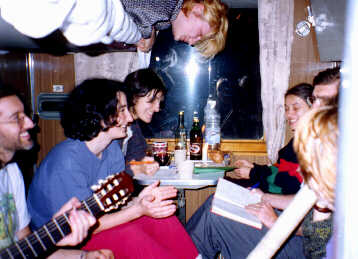
|
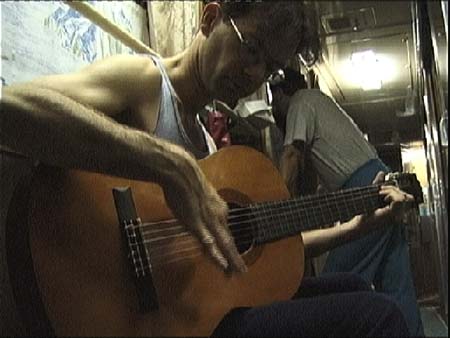
|
| Singing songs to the guitar in a compartment one evening between Moscow and Novosibirsk, also Berthold playing in the corridor |
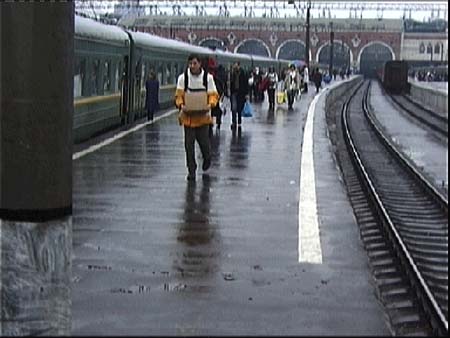
|
| Dietrich carrying his heavy box of leaflets about the "ecobalance of the Climate Train" along the platform in Moscow Kazansky station as we boarded the "Yenisei" train |
On most Russian trains we occupied "Kupe" carriages, which have four beds per compartment. There is a small table to work or eat upon, and luggage can be stored under the seats or in a large space above the corridor. The windows all have pretty curtains and sometimes even plastic flowers are provided on the table. The corridors are carpeted and have folding seats -good for watching the scenery or people coming and going. The toilet and washing facilities are basic, but boiling water from the samovar is always available for making tea or noodles.
There were also wooden racks for tourist information, which we used for our library, stuffing them with books and papers about climate change and about the Trans-Siberian railway, Russian, Chinese and Japanese dictionaries, and any other information we wanted to share. Nothing was stolen -although we had three notebook computers, a video camera and other expensive equipment. Over such long journeys people get to know each other and the provodniks (attendants who occupy their own special compartments in each wagon) keep a careful eye over who enters and leaves at stations. They were also responsible for hiring out sheets and pilllowcases, as Sco recalls:
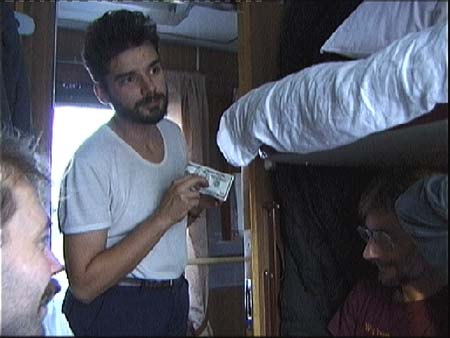
|
| Igor trying to translate that we needed to pay the Provodnik for hiring the sheets |
Travelling through Russia in winter gave as a real sense of the vastness of the country, with endless birch trees and expanses of white snow. The weather and scenery gradually changed. as we went further east. In Moscow it was quite warm and raining, and we first encourntered snow crossing the Ural mountains through a winding river valley, but after this for many hours nothing seemed to change, as we crossed the enormous flat plain of the Ob basin, frozen puddles of ice among the marshland and forests.
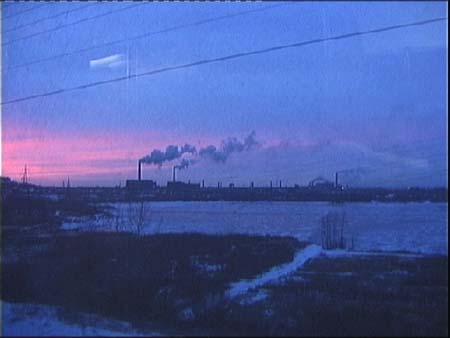 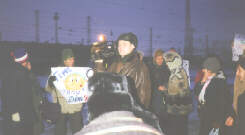
| |
| Crossing the Ob as we arrived in Novosibirsk, the evening sky was bright red, possibly due to the smoke from forest fires which were still burning. When we stepped off onto the platform we were immediately blinded by press photographers who had come to welcome us | |
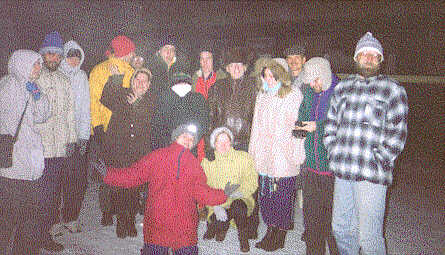 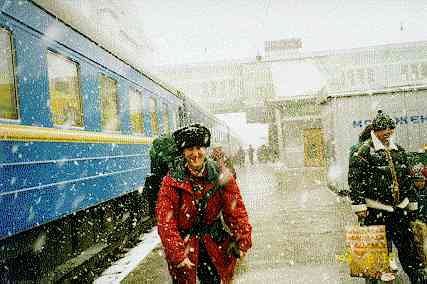
| |
| The main group bids farewell to the Siberians on the platform of Novosibirsk station in December -the thermometer read minus 33 C! In April (when Ben returned) it was a little warmer but still snowing (note ice-cream stall!) | |
In Novosibirsk there was little snow but it was very icy and slippery on the pavements - about minus 10 degrees. Bianca and Zuzanna remarked upon the massive Soviet style buildings which were similar to ones in Romania and Poland. Most remarkable was to find in the middle of Siberia a ballet theatre and a metro, just the same as in Moscow! Amy Taylor had arranged for us to stay with local families, which gave us a good opportunity to learn more about local life. Here Michelle Valentine recalls,
When we arrived in Novosibirsk I confess I imagined it to be a really bleak inhospitable place, very gray and dark. But in fact I thought it was quite a lovely city. and I was very cheered by the friendliness of the all the people we met.
On the return journey it dropped to minus 33 degrees in Novosibirsk. Bianca was surprised that people could survive at such low temperatures! However many people remarked on the warmth of the Russian people, like Dietrich Brockhagen who enjoyed listening to the folk songs played by the local people at our party.
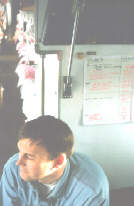
|
| Kostya sitting in the open "platzkartny" wagon near his home city of Krasnoyarsk. A workshop agenda is attached behind him |
On the train between Novosibirsk and Irkutsk we were in a "Platzkartny" wagon. This is an open carraige without compartments, and bunks for 54 people which fold up during the day. It was not so comfortable but we had no option as we had to buy these tickets at the last minute due to ticket problems (as explained in the chapter "bureacratic barriers to sustainable travel"). Much of the next day was spent trying to arrange further tickets from Irkutsk using our satellite telephone, which was not easy in a blizzard while the train wound through the hills near Krasnoyarsk.
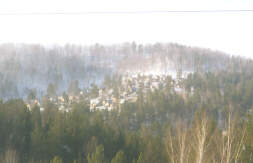 | 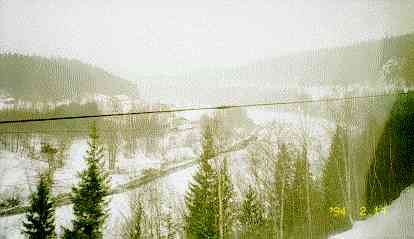
|
| Siberian village nestling in the hills near Krasnoyarsk, and a river valley in the Ural mountains (return in April) | |
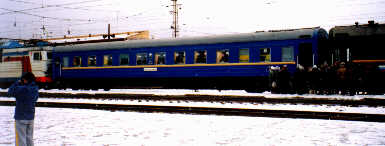 | 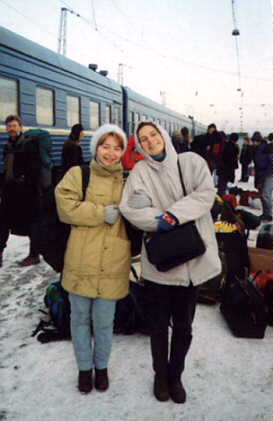 | 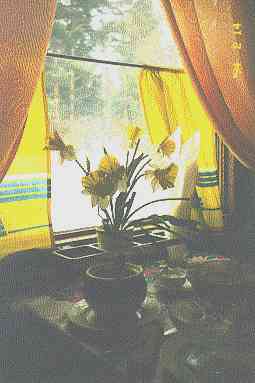
|
| Our special "goluboi vagon" (=blue wagon, also a well-known Russian children's song which the Siberians sang). After the ticket crisis, we were so happy to have this wagon attached to the Beijing train in Irkutsk, even if it could only travel with us as far as the border. Here are Irina and Zuzanna on the platform. The wagon was pretty inside, there were even plastic daffodils! | ||
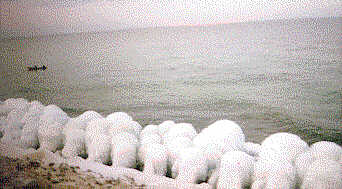
|
| Ice boulders formed as the waves splashed on the shores of lake Baikal in December |
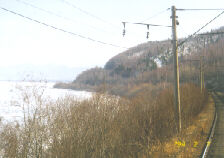
|
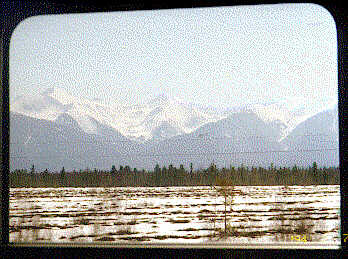
|
| Scenery near lake Baikal in April. The train runs along the lakeshore, on the opposite side of the train (to the south) are the mountains |
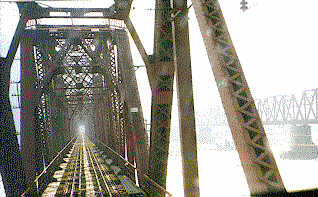
|
| View from the last wagon of the bridge across the Selenga river |
However eventually we succeeded in persuading them to hitch a special blue "kupe" wagon onto the train to China which we boarded the next morning in Irkutsk. From there the train climbed up high and then suddenly we emerged through a tunnel high above lake Baikal which stretched further than we could see into the distance. The train descended many hairpin bends and stopped at Sludyanka at the head of the lake. A few of us ran down to the lakeshore to take photos while others bought fish for lunch. The train then wound along the lake shore for several hours before following the Selenga river through the mountains to Ulan Ude. Beyond this the green forests of Siberia rapidly thinned out and changed into the dry brown grasslands north of Mongolia.
The trains trundle steadily at about 80 kph , but when they reach a main station they stop for up to half an hour while the wheels are checked and even sometimes wagons and engines are added, so you can stretch your legs and buy a few things from the local traders who come to meet the train. At Sludyanka station at the southern tip of lake Baikal a few of us even ran out through the village to the lakeshore for a quick photo opportunity, although we had to hurry not to miss the train and our return was almost cut off by another long train arriving on the next track. Meanwhile others bought lovely smoked fish from the lake from the old women selling them on the platform. When Britta opened hers she found it was full of caviar! They also sold hot potatoes, smyetana (a kind of sour cream), pickled vegetables, beer and even ice cream.
Some of the group, e.g. the Russians, the two Georgian ladies and Zuzanna from Poland were used to taking their own food and drink on such journeys, so we were able to share vodka, jam, honey and cheese. We set up a kitty system, so that those who bought odd items of food or equipment for the group could be reimbursed every few days. The system was devised by Sean Hughes and Christina Kopernik-Steckel, who had to keep very careful records of every transaction, and also collect receipts for our accounts. It took a while for the system to become fully operational, since during the first days of the journey things got more and more complicated as new people joined the group. Thus we had one daft episode on the train between Moscow and Novosibirsk, where Peter Hundley and Zuzanna Iskierka were dividing out food bought in bulk for the group, and so that it was absolutely fair some of us ended up being given half a slice of bread and a couple of segments of an orange! For those who were having their costs paid, we also devised a system of allowances, at a rate per day which reflected the cost of food, (i.e. the rate was higher in Japan than in Russia and China).
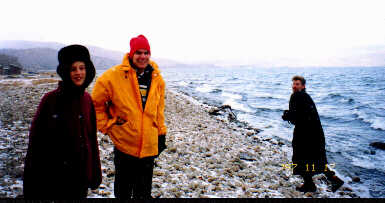
|
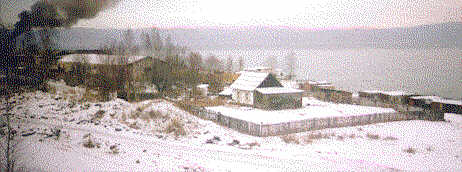
|
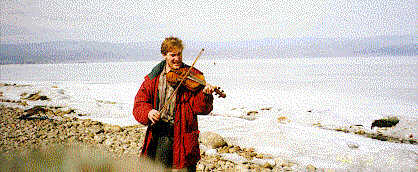
|
| By the shores of Lake Baikal, in November (outward journey, with Michelle, Dietrich, Peter), December (return journey -main group), and April (Ben returning after 3 months research in China). The lake is frozen from January through May. These pictures are taken by the lakeshore at Sludyanka |
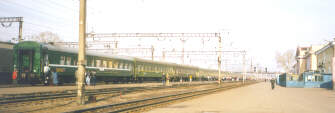 |
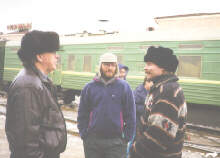
|
| The Beijing-Moscow train in Ulan Ude station -it was about 18 wagons long. At major stations people got off to stretch their legs. Here are Bob, Richard, Wolfgang. | |
Communication while travelling
Communication en route was rather difficult. For email we had investigated the possibility of renting a small satellite receiver but this was not feasible since this receiver requires quite a stable power supply and train's power does not meet this requirement. The satellite telephone could sometimes solve the problem, except that whilst one person was using it, another had to ensure that the receiver was pointing at the satellite, and each time the train went around a bend or through cuttings, forests or snowstorms the connection was often lost. This meant that we could not receive telephone calls, faxes or emails easily, and so we could not send as many reports and information to our colleagues at home as we had hoped. Bob Kenyon explained:
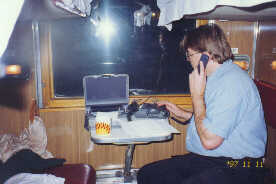 |
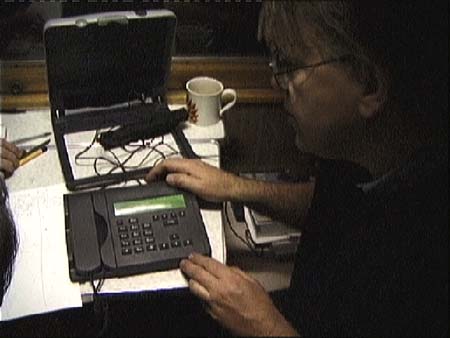
|
| Bob on the Satellite telephone one evening. The box always had to be pointing south to see the satellite, so whenever the train went around a bend somebody had to adjust it, and in cuttings or forests or snowstorms we often got cut off! | |
Probably in the 20 minutes maximum we got at each railway station we would have found it difficult to locate a phone and set it up for data transmission. We never got the satellite phone working for fax or email because it was in use all the time for emergency calls about visas or wagons, or the train was in a cutting, or we were travelling south, or we were in mountains, or we were among high-rise buildings, or it was recharging, or someone was shaving, or the provodnik was vacuuming or we were arguing with the provodnik about turning the power on again! Next time we will take a renewable energy source with us.
However when we did get through the quality of the connection was sometimes very good. Richard Scrase recalls
The role the satellite telephone had in allowing people to keep in touch with their loved ones was very important for group morale, and the role it played in allowing us to know what was about to happen ahead of us, proved to be vital for the success of the trip.
On a couple of occasions when we had to send very important information to others, (for example the passport details for everyone in the group had to be sent to Rush Zhou so that he could book the ferry tickets) some of us had a mad dash into the station when the train stopped to send a fax from there. Somehow the station staff did not seem very surprised by this.
There was a problem with the electricity supply on the trains. Although there were 240V shaver sockets at the end of each wagon, the provodniks were not happy to let us use these for more than about half an hour at a time, but it took several hours to recharge the batteries of our three notebook computers, the satellite telephone, and the video camera. We also had a computer printer which we used occasionally to print faxes and information about workshops and meetings. We tried to sneak wires under the carpet into our compartments but they could detect from a control board that we were using the electricity and would switch off the circuit. Apparently they were concerned that the transformer used to produce the 240Vsupply would overheat, but the train engineer could occasionally be persuaded otherwise by a small bribe. Often we had to ration our supply according to which item was most important at the time -usually the satellite telephone.
As we went east the time difference also made it more difficult to communicate with Europe- usually we lost about an hour every day. Timetables were displayed in the wagons telling us how long we would stop, we were often unsure what time zone we were in. To coordinate workshops it was important that our watches all agreed, so Bob took on the role of timekeeper. It was especially confusing when we crossed the border from Russia into China as our clocks had to move back one hour westwards to Beijing time.
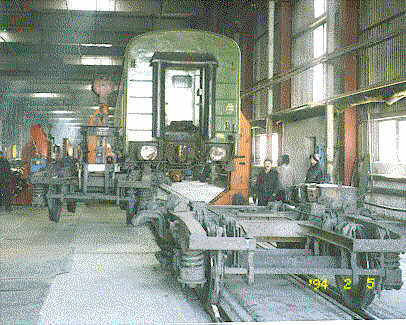 |
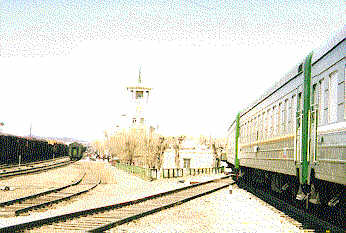
|
| Changing the wheels at Zabaikalsk on the Russian-Chinese border, which is necessary because the Russian tracks are slightly wider than in China or Europe. The bogies are unscrewed from the wagon, which is then raised up by the orange lifts (an odd sensation if you are still inside!). The old wheels are rolled out, and removed by an overhead crane. This procedure is reversed for the new wheels. Separating all the wagons and shunting them in and out of the shed (right) takes ages! | |
At the borders of Russia the wheels have to be changed because the Russian gauge is slightly wider than in Europe or China. This operation used to be top secret but now they did not even mind us filming it. This took much longer in Zabaikalsk (Russia-China border) than at Brest (Polish-Belarus border) because there is only one passenger train a week and so few staff are employed to do the job. We were worried when they did not change the wheels of our ‘blue’ wagon , but after seven hours of waiting around, sipping soup (very reluctantly served to us in the station restaurant with its great dark wooden panels), playing games, being plunged into complete darkness during a power cut, and eventually having our passports inspected, we were found scattered places in other wagons.
Bob recalls his first experience of changing the wheels:
Polish/Belarus border - the changing of the wheels at the border, at night , under the glare of the lights, the carriages raised, wheels taken away, something of the Devils work-shop.
While we were waiting, the officials got interested in our satellite telephone as Richard Scrase’s diary recalls:
Ben and Sergey were called into the Station masters office. A problem with the satellite-phone! Bob, Yuri Doublianski and I were also called in! ‘Did we have a license for the phone?’ they asked. We showed him the bit of paper Bob had had the foresight to ask for in Moscow. ‘This is not a license’ Bob quietly says to me, if anybody has to go to jail, I suppose it should be me. Also, do you have an export license?, says the Stationmaster. ‘No, we are not exporting the phone, we will be bringing it back’, we replied brightly. Sergey exerted his full diplomatic talents, then we were asked to leave the office while the Stationmaster consulted with his staff. Sergey was called in again, and then emerged soon after, smiling. Problem over and better still, the climate train team were asked to sign their autographs on a copy of Dietrich’s green ‘climate train’ leaflet.
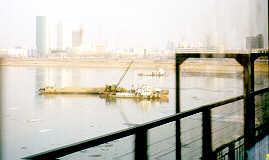 |
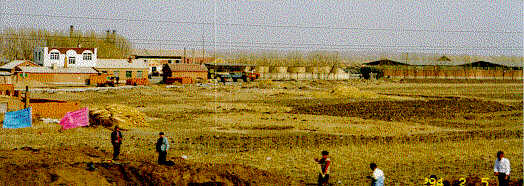
|
| Crossing the river into Harbin was our first view of a large Chinese city with its shiny new skyscrapers. Here is a typical rural scene between Harbin and Shenyang. We saw many of these round huts that look more African than Chinese: apparently they are grain stores | |
Travelling between a European and an Asian country brought us to appreciate the vast cultural differences that can exist either side of the fence across the inhospitable grasslands, which we crossed in the late evening.
At Manzhouli station all of the Chinese travellers had to leave the train and line up at an office at one end of the platform. We later discovered they were being tested for AIDS. The young "health and safety" inspectors annoyingly confiscated all our fresh fruit and vegetables, but they did not seem bothered by the live puppies being smuggled in bags across the border, probably intended to be sold as pets somewhere in Southern China.
We were all keen to try some Chinese food from the many stalls garishly lit by a string of electric light bulbs, and soon we were returning with interesting combinations of beer, ice-cream, noodles, and mysterious hot take-away meals that emerged from steaming vats. Many of us bought unidentifiable but colorful packets, curious to see what was inside. Bob bought one that turned out to be chicken’s feet, although even the Chinese on the train were dubious about eating them! There was a great deal of packaging surrounding all food in China and Japan, in marked contrast to Siberia. Many of our group thought this wasteful and unnecessary, particularly the disposable wooden chopsticks. On the train we ate mostly pots of instant noodles and rice, but we also arranged one big meal for the group in the Chinese restaurant wagon -this being the only place we could have a meeting with everybody together. Alexander Kuzmenko recalls:
The funniest moment was when we were trying to explain that we needed a receipt in the Chinese restaurant car!
The next morning we were able to see a very different landscape from the forests of Siberia, as Richard Scrase describes:
I
woke to the early morning sun revealing a frozen river winding across a plain trapped between mountains. The mountains were not particularly high, but some of the rocky outcrops were superb, a little reminiscent of the Picos of North Spain. The landscape though was parched, brown, all water frozen. Reed beds emerged from thick white ice. The only sign of wild life, a buzzard flying slowly across a burnt stubble field. Occasional homes started to coalesce into regular villages as we swept down the valley. Neat red brick single-storey houses, roofed with tiles or thatch, each enclosed with a compound by a wooden fence. Yellow corn or tobacco, dries on roofs or in piles laid out in the yards. Hay, sticks, logs and geese. Rural ChinaAs we neared Harbin we saw little nodding-donkey pumps extracting oil out of the swamps. We then swept over a great river and into a modern shiny Chinese city. But now the train seemed to be in a great hurry, and did not stop for long. That evening we were rattling along beside a motorway near Shenyang, the train tooting as if to compete with the bright lights of the cars. By the time we awoke the next morning, we were undeniably back in the busy modern world as we approached the suburbs of Beijing. Richard’s impressions continue:
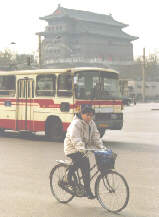
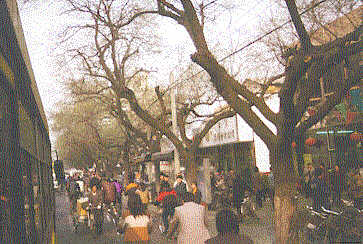
|
| A bus and a bicycle by the drum tower, and a street near our hotel in old Beijing |
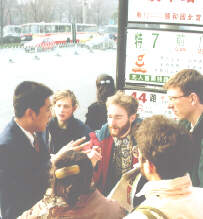
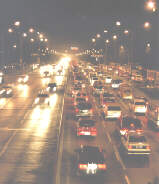
|
| Even when we had worked out which number bus to catch to our conference at the Agrometeorological institute, it took many hours to get through the busy streets. The government's solution to the congested traffic was to build four orbital motorways, and consequently the smog is terrible, causing both local cooling (aerosols reflect sunlight) and global warming (CO2) |
My senses were assaulted by the noise and smell of a thriving, bustling city. Old, small houses being demolished to make way for sky-scrapers. New blocks of flats with ‘Chinese -curved’ roofs, somtimes the only clue that you were in Beijing. Men straining to pull three-wheel cycle carts piled high with charcoal briquettes. Food being cooked and served on the streets. Terrifying traffic, cyclists weaving in and out between cars and minibuses, all making way for the honking buses. The only traffic rule - watch out!
Many like Zuzanna Iskierka, Oras Tynkkynen and Bianca Lotrean commented on the smog hanging over the city and the general craziness of the streets. Dan Swartz had been to Beijing before and commented that
Beijing had changed a lot in the ten years since I was last there. Then it felt like I was the only foreigner, and there were no private cars!
However , on the third day while walking to the office of "Friends of Nature" we did discover the ancient streets of hutongs in the centre of Beijing, and the bright city was charming too. Bianca Lotrean recalls:
In China I liked the use of colour in decoration, like a circus!
We slept three nights in the Jin Lang hotel, conveniently situated near the railway station. It was a very new tall building and we were among its first guests which is perhaps why our travel agent Rush Zhou had managed to arrange such a good deal for our group. We were dispersed in two- person rooms, but it was easy to spot other people coming and going as the rooms were on semi-circular floors surrounding the central lobby , where lifts of transparent glass continuously rose and descended . If we hadn’t been so tired it might have felt quite glamorous!
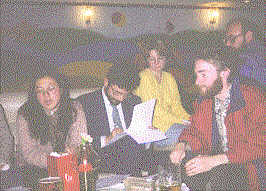
|
| Sun Yu and Igor in the hotel lobby discussing how to get to Kyoto, since they wouldn't get Japanese visas in time for the ferry |
We spent much of the first day writing faxes and making phonecalls about Japanese visas (see "bureaucratic barriers to sustainable travel"). The second day was our conference in the Agrometeorological institute (see next chapter).
On the third day some of us went to a meeting with "Friends of Nature" (see next chapter), whilst others went shopping to buy various items for the aircraft action and street theatre they had been planning for the Convention.
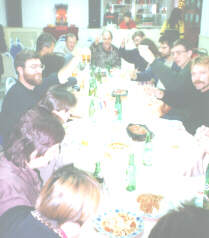 |
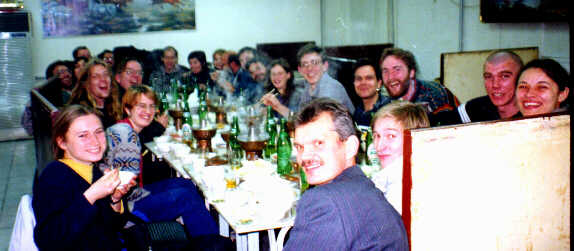
|
| Late night feast (left) to celebrate getting Japanese visas, and the first meal all day for those sitting in the embassy. Another late-night meal (right) cook it yourslef Mongolian hot-pot, in Tianjin on the retrun journey | |
Everybody really enjoyed the food we ate in Beijing, both from vendors on the street - spicy pancakes and large baked sweet pototoes, and in small cafes whose cooks, guessing what we might like, never ceased to surprise us with a wonderful variety of dishes. The only problem was convincing them that we hadn’t any room for the traditional dumplings and soup at the end!
As we assumed that food would be expensive on the Japanese-owned ferry, we all went shopping in Beijing before we left and lugged with us great bags of fruits and nuts, pots of noodles, cakes and biscuits, bags of spicy vegetables, tea and soft drinks. We didn’t actually need so much food as the meals in the ships canteen, a pleasant combination of chinese and japanese styles, were quite reasonably priced, and due to the stormy weather many of us were not very hungry anyway!
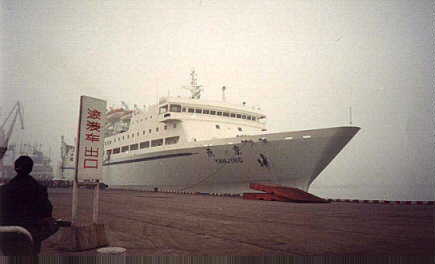
|
| Our ship "Yanjing" in Tianjin port |
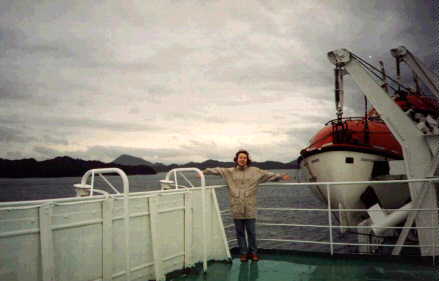
|
| Although it was damp and windy, we enjoyed the fresh air on deck warmed by the Kuroshio current |
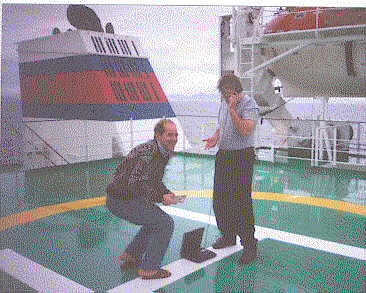
|
| Sergei and Bob succeed with the satellite telephone on the ship! |
The ferry "Yanjing" from Tianjin to Kobe was made in Japan but run by a mostly Chinese crew. There were berths for about 90-passengers. in three classes of accommodation - open rooms with Japanese style tatami mats, rooms with 16 bunk beds and rooms with 6 bunk beds. European passengers were very rare so they welcomed us with garlands of flowers and on the return journey upgraded us to the best rooms without extra charge. Everywhere was immaculately clean. At our meeting with the captain we were told the ship weighed 9860 tonnes, and the journey was 1900km. This was the 799th voyage it had completed since being commissioned 8 years ago, and in that time they had carried over 80 000 passengers, although most of the income came from freight transport. We also asked the captain whether he had observed any climate change over the last decade, he said maybe it was a little warmer.
The ferry passes through the Bohai Sea north of the Shandong peninsular, south of Korea, and then through the beautiful "Inland Sea" of Japan to Kobe. The temperature rose from just above freezing in Tianjin to 25C as we passed Hiroshima, due to the warm Kuroshio current. However the wind blew up to gale force 8 and the sea was rough as Bob Kenyon describes:
On entering the Yellow sea, there was a 50 meter wave-length swell, and I looked along the troughs to the horizon, it was like the parting of the waters.
This made many people quite ill and unable to enjoy the scenery and take part in workshops, which was a pity since there was much more space for large group meetings than on the train and we had intended to finalise our strategy for the COP. We did meet an interesting character Professor Yoshihisa Arai (who we nicknamed ‘The Professor’). He had made a similar journey to us via central Asia,and was assisting with the preparations for the Winter Olympics. He was very cheerful and explained to us some of the subtleties of Japanese etiquette and culture. Later, when our bicycle journey was staying near his home in Takarazuka, he took Ben Matthews on a long tour of the Osaka metro system just to buy a guitar string!
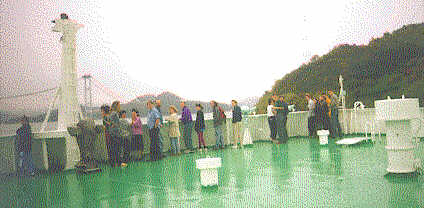
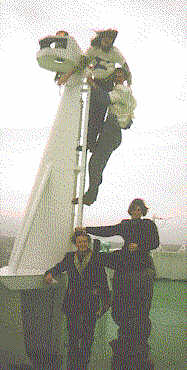
| |
| On deck watching little green islands spotted with orange trees in the beautiful inland sea of Japan. We were about to pass under the longest suspension bridge in the world | |
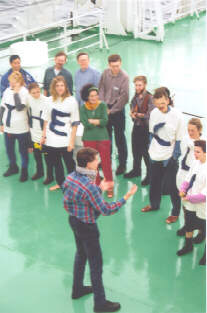
|
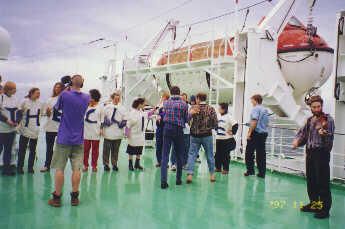
|
| Rehearsing our "climate song" on the helipad of the ship while we were sheltered from the big waves by the islands. Choirmaster Dietrich explains the harmonies. | |
On the final morning, although the wind blew just as strongly, it was a little calmer due to the shelter from the many islands. So we were all marshalled by our ‘choir master’ Dietrich Brockhagen to practise our ‘Climate Train Song’ on the Helipad at the front of the ship. This was later performed at press conferences in Japan, and at the street festival in Kyoto. The group was divided into three, and each beginning the chorus one after another, i.e. in a round. Dietrich insisted that we had to get it absolutely right!
1. Climate Climate Climate Climate Climate Climate Climate Change,
2. Stop stop stop, stop now Climate Change
3. Its dangerous, its dangerous stop now climate change,
We had planned to organise a workshop to write some more ‘sophisticated’ songs about climate change, but there was never enough time.
Due to the wind we didn’t arrive until the evening of 26th November. Dark storm clouds had gathered over the hills but the bright coloured lights reflected in the waves from the space-age skyscrapers of Kobe welcomed us unmistakably to Japan. We saw dozens of press cameras waiting on the quayside so we hung our banner over the side of the ship and lined up with our T-shirts, although it was too noisy to sing our climate song until we had gathered in the main hall after passing customs.
In the pouring rain our many japanese friends escorted us on to the "portliner" train to the party and barbecue (under a canvas cover!) waiting for us in the Genki village.
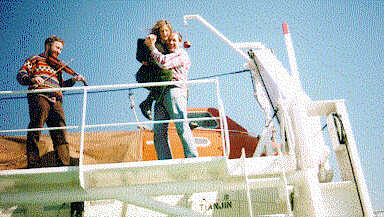
|
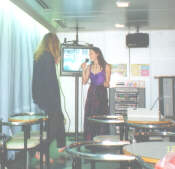
|
| Here Ben is playing the fiddle by the lifeboats, and Michelle and Sean are trying the Karaoke. This was on the return journey, when we had more time to relax. We also enjoyed the Sauna but we didn't have any photographs of this! | |
Kobe and bicycle journey
We were given a tremendously warm welcome in Kobe (for further detail see the next chapter) and were accommodated with Japanese families in Genki village, a complex of small temporary houses erected by the local authorities after the devastating earthquake there January 1995.
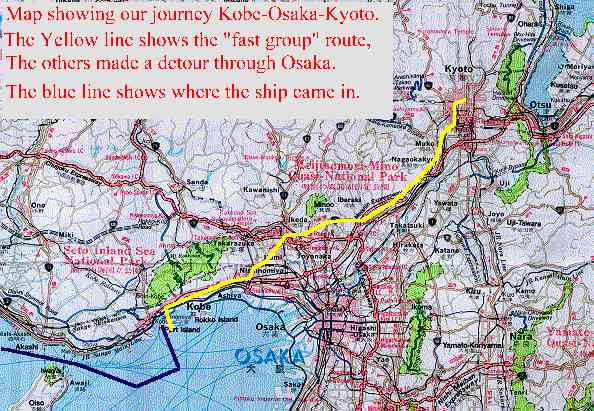
The next morning most of us set off on bicycles, in a long line lead by local students, to make the 80km journey from Kobe to Kyoto. A few people went by train because either they did not want to cycle, or they wanted to have some time to plan their work. The hire of the bicycles had kindly been organised by ASEED Japan and the "Cool Earth Campaign" (They also arranged for us to rent bicycles in Kyoto for getting around the city). When we stopped for lunch a tray of hot bundles of glutinous rice and sushi wrapped in seaweed suddenly appeared. We grew accustomed to such snacks which could be bought at any corner shop in Kyoto. The first evening we all stayed in a catholic church hall, and for the first time since the journey began we were able to cook our own dinner - large pots of miso soup and of noodles, rice and vegetables. We also played some games and sang some songs as Dietrich Brockhagen remembers
What I would tell others about was Pete (Hundley) singing the blues in the church in Japan, imitating all of us in turn!
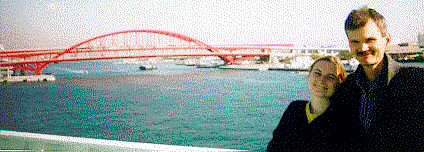
|
| Zuzanna and Yuri (C) by the bridge carrying the "portliner" elevated railway across the harbour. There are even flyovers for bicycles in Kobe, which had to be entirely reconstructed after the earthquake |
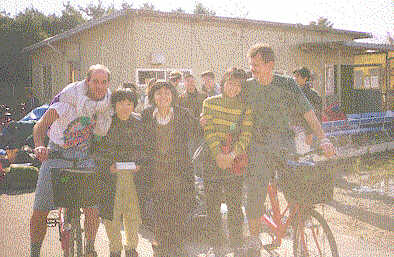
|
| The Siberians, with our Japanese friends, about to depart from the temporary Genki village in Kobe |
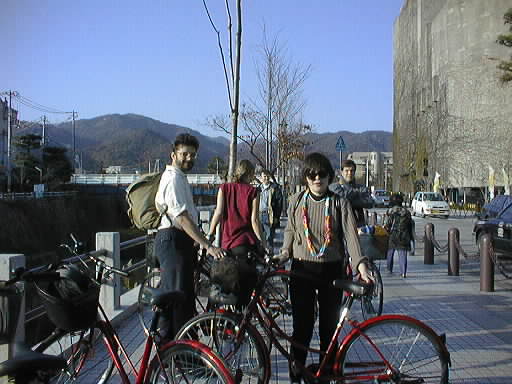
|
| Kobe is long and thin, trapped between the sea and the mountains, which can be seen behind Igor and Olga |
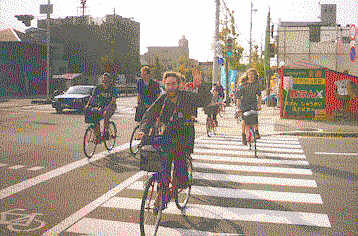
|
| Ben has the satellite telephone in his basket to call the UNFCCC secretariat to arrange events during the COP |
Many people remarked on the general polite and friendly disposition of the Japanese, but not all appreciated the orderly way that things were done.
In Japan I remember the people riding bicycles in suits on their way to work, , the people were very friendly, kind and hospitable Zuzanna Iskierka.
The people, especially in Kobe, were lovely and generous. But Japan was so planned, worse than Germany or Holland. Dan Swartz
Bob, on the other hand was impressed by attempts to save resources:
The driver of the bus I was on yesterday turned off his engine at every red traffic light. Very large numbers of houses in the Osaka-Kyoto district have water-heating solar panels on the roof -maybe one in five.
The following day a ‘fast’ group decided to cycle ahead to try and reach Kyoto that evening to make arrangements for events in the COP. The rest of the group continued as planned and stayed at Hattori Ryokuchi Youth hostel. There they gave a presentation to a local citizens group about the Climate Train. On Saturday 29th November they met up with the first of group of Japanese cyclists who were part of a national demonstration of cyclists groups making their way to register their opinion at Kyoto (Eco-relay). They were met by a number of local mayors and other civic representatives, and made speeches at each meeting. Unfortunately during the last leg of the journey it rained very heavily, so most of the cyclists decided to take a train for the last part of the journey, although a few insisted on going all the way to Kyoto. Here Richard Scrase describes what is was like to be a cyclist in Japan.
People here, no matter how tall or big they are all seem to use the same kind of bicycle (not really made for European size). Which means that some of us (e.g. Phillippe and Yuri C.) didn't really have the time of their life. Biking in Japan makes you realize that we finally have to accept that we are back into civilization. Quite hard in some ways after all that pure nature in Siberia and China. Biking here is really exhausting. An incredible amount of cars and few bicycle paths, so we had to be zigzaging around the pedestrians on the sidewalks.
However Michelle and Ben, in the fast group, found a very pleasant "historical road" from Kobe to Kyoto, a long narrow windy street between traditional houses with curly tiled rooves and bonsai trees, which just occasionally emerged to cross the concrete motorways and elevated bullet-train lines.
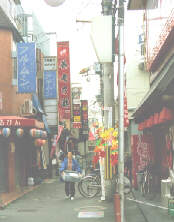
|
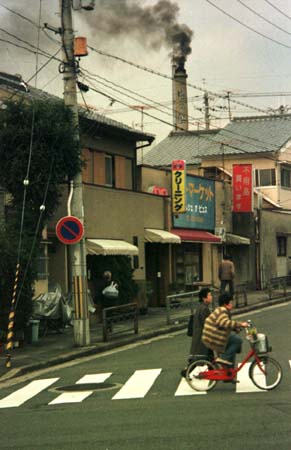
|
| Little back streets, Kyoto |
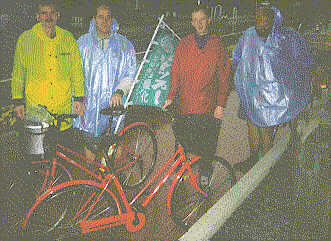 On the third day it poured with rain. Here are wet Siberian cyclists! Notice the COP3 flag
On the third day it poured with rain. Here are wet Siberian cyclists! Notice the COP3 flag
|
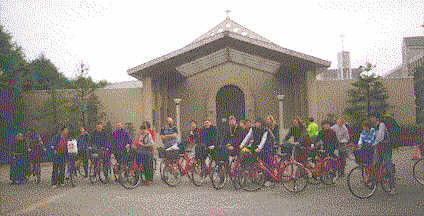 The group about to depart from the Christian church where we stayed on the first night of the bicycle journey
The group about to depart from the Christian church where we stayed on the first night of the bicycle journey
|
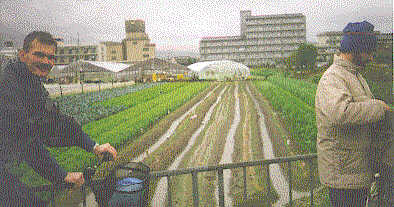
|
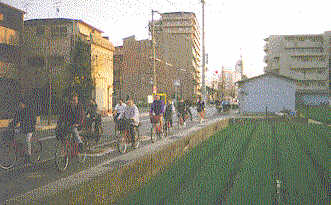
|
| Although Kobe-Osaka is a huge city, we passed many plots of rice and vegetables between the blocks | |
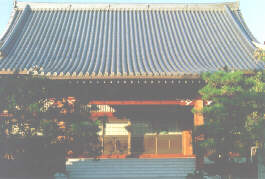
|
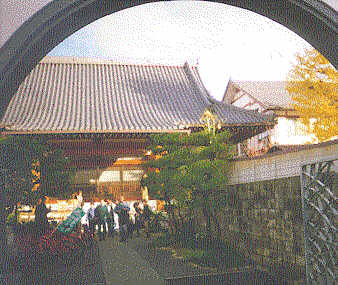
|
| The Kenso-zen-in temple where we stayed in Kyoto. Bicycles can be seen throught the moon gate | |
In Kyoto, ASEED Japan had arranged that we could stay either in Ritsumei University , or at the Kenso-zen-in, a tradiational japanese temple in the centre of the city, both of which were made available for visiting NGO delegates to the COP. Three of our group preferred the university as the rooms were more peaceful than the crowded temple, but the university gates were locked at 10pm each night and it was not nearly so atmospheric.
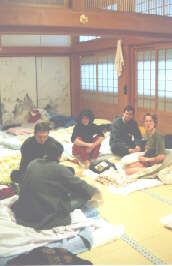
The beautiful old temple was the exact opposite of the space-age concrete Convention centre. The floors were covered with traditional tatami mats and the walls were made of paper painted with mountain scenes, in wooden frames that could be moved to change the division of the rooms as required -there were no doors as such. We all slept on futons on the floor, which were rolled up during the day to provide space for meals and for planning our work. In the centre of the temple was a special room with a shrine, which was used for meditation. There was also a large kitchen where we could cook food, but only limited washing facilities. However just next door to our temple were traditional public baths -another great experience of Japanese culture.
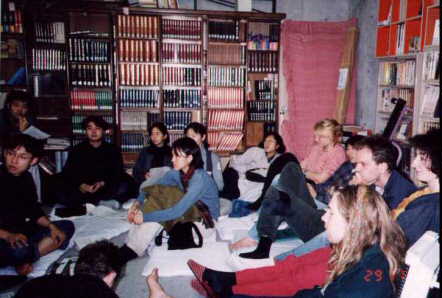
In the basement of the tmple was a library, which we and the Korean group used for a meeting room |
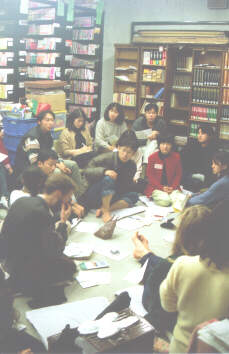
|
First you have to wash yourself at a tap, then you can enter the bubbling hot bath, a herbal bath that looked like strong tea, an even hotter sauna, and then when this was too much to bear, the freezing cold bath and shower outside. One could sit in the cold water, in the dark and listen to the singing of the little caged birds that abound in both China and Japan, and then go back inside for another hot dip.
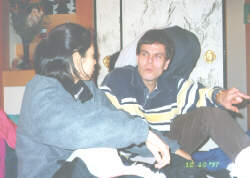
|
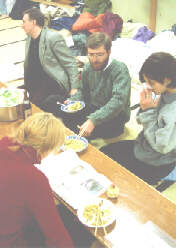
|
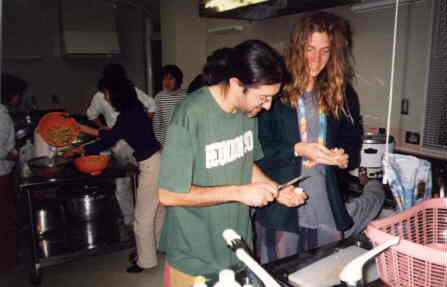
|
| Mealtimes: Sean and Dan's turn to cook |
Around the corner from our temple was the office of the "Cool Earth Campaign" which they kindly let us use to send faxes and emails, and photocopy information. We also had the use of a library in the basement of the temple for meetings and setting up computers. In the corridor we set up many noticeboards to tell each other about the many parallel events going on all around Kyoto, particularly important since there were many late evening receptions both in the Convention itself and in the city, so it was very hard to arrange meetings to suit everybody.
On the evening before the Convention began (i.e. the 30th November) we held a meeting to plan our activities. We were scheduled to make a Climate Train presentation in the UN conference hall the next day (see next chapter) so we had to plan the order of speeches. We also agreed to produce a press release, and then it was time to sort out domestic details.
Although the accommodation was very pleasant, we were sharing it with a large group of Korean activists, and thus we had to agree various ‘ground rules’ to enable us to live together for the next two weeks. We also had to respect the fact that we were sharing the accommodation, not just with other activists but with the monk and his family. Yet he was very kind and tolerant, and even organised meditation and flower arranging sessions for those who wanted to try this, to help us focus our minds for the day’s activities.
We drew up a rota for cooking and cleaning, so that everyone had an equal share of the work. Our evening meals were thus a surprise each night since we had a different group peparing them. Mostly we cooked vegetarian dishes, although Berthold cooked some very tasty small fish. Local people also brought gifts of unusual home-grown produce to the temple, which the monk would demonstrate how to cook. We would eat in true Japanese style, ie sitting on the floor around long low tables with communal dishes in the centre for everyone to try. We occasionally had warm Sake, to unwind after a hectic day.
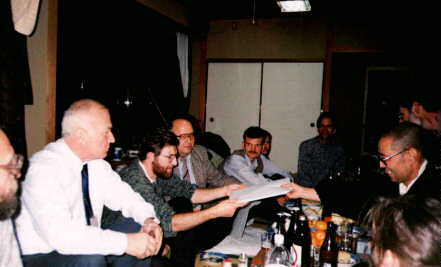
|
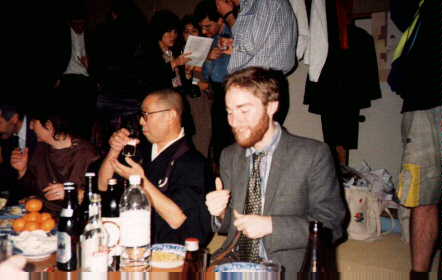
|
| One evening Marina invited Tengiz Gzirishvili and colleagues from the Georgian delegation to eat with us. Meanwhile, Ben chats to the monk. | |
One of the advantages of travelling together was to have some extra time to discuss climate change before the Convention with people from many different backgrounds and a wide variety of experiences.
On the train we could only have small workshops - up to ten people in one compartment! Many of the workshops were held more than once, to give everyone a chance to take part. Some workshops were for exchange of information, such as those given by Philip Pernstich about the background to the Climate Convention process, explaining all the acronyms and procedures, and Ben Matthews’ workshops about Biogeochemical Climate Feedbacks and Climate Engineering (more detail on these can be found in the introduction chapter and also under activities in the COP).
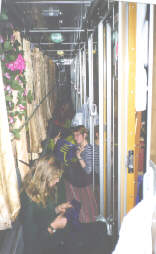
|
| Dan and Maggie in the train corridor sewing chinese characters for the T-shirts |
Ben and Zuzanna also taught the Russian alphabet and some basic phrases before we arrived in Moscow, and as we got close to China Ben gave a couple of introductory classes in Chinese. A team of people had to be taught basic Chinese caligraphy so that we could sew the characters for "Climate Train Europe-Kyoto, Reduce emissions of greenhouse gases" onto our T-shirts in place of the English "Save the Climate" (Chinese is much more compact than English!). This cutting and sewing continued for hours whenever there was a moment to spare.
Marina Shvangiradze gave workshops about her work with the Georgian Government, and their efforts to increase the production of energy in a sustainable way. In Georgia they have great potential for developing renewable energy but very little money to fund such projects. Unless Joint Implementation can provide these funds, they may have to resort to building a cheap coal-fired power station instead.
Some people spent many hours planning actions for the Climate Convention (see later), particularly focusing on the greenhouse emissions from aircraft. This not only involved discussion of what kinds of actions we wanted to do, but also making the materials to go with then such as banners, posters and publicity material.
Workshops were also held to plan the group’s activities. After the meeting in Warsaw we discussed what lessons we had learnt from the way we had presented ourselves to the media, and devised better strategies for future press conferences.
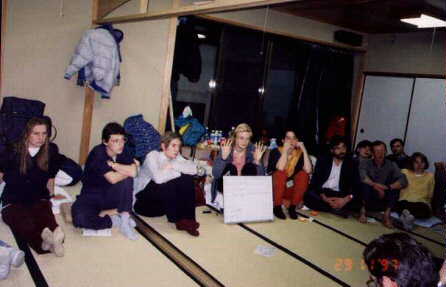
|
| A meeting in the temple in Kyoto |
During workshops we often used handsigns to facilitate our discussions and speed up decision making. We were surprised to find how many people from our group were already familiar with using these in environmental organisations in their own country, and they are particularly useful in a multilingual group. However this idea was completely new to the Siberians and Chinese. The main signs are:
Daniel Swartz, whose organisation Zhaba Collective specialises in teaching such consensus decision making methods to environmental NGOs, placed a leaflet describing these signs into the pigeonholes of every national delegation in the Climate Convention, in the hope that they might not spend so long repeating each other, for example when congratulating the Chair on his re-election! Dan also led many workshops for us on the train and the ferry about local action planning, networking, fundraising, consensus decision-making and effective meetings.
However consensus decision making is a slow process even aided by handsigns and this did cause some difficulties. We were not a single organisation but a very diverse group with many different priorities and expectations, yet the rapid pace of events often required very quick decisions about group activities and made it difficult to delegate tasks. Moreover Ben Matthews, who was responsible for most of the funding of the Climate Train project, who had arranged the contacts with the local conference organisers and the Convention secretariat, and who was the only one to speak both Russian and Chinese, inevitably had to bear much more responsibility than others for arranging events and ensuring the success of the whole project. Therefore he felt that it was not realistic to expect everybody to play an equal role in making decisions.
The main problem was that, although we were travelling for six days between Moscow and Beijing, we did not have as much time for workshops as we had hoped because Ben, Sergei and Michelle had to spend so long making frantic telephone calls about tickets and visas, and we also changed wagons several times which wasted a lot of time with packing and unpacking (see "Bureaucratic barriers" chapter for the explanation of this).
On the ferry we had much more space for whole-group discussions, but many people felt seasick due to the stormy weather so we could not stick to our ambitious schedule. As Tatiana wrote for her local newspaper:
The ferry was hige, nice and comfortable, but storm is storm and sea-sickness is sea-sickness. We did try to continue the workshops, but quite soon everyone was back in bed -I came to my senses only near the port of Kobe
However we did have a long strategy meeting followed by a climate policy discussion, which is described below . Also, on the return ferry journey when we were more relaxed we had some very good workshops evaluating our experiences and discussing ideas for future projects together.
Finding a common climate policy for the COP
The Climate Train had always been promoted not as a single lobbying organisation but as an opportunity for anybody who wished to get to Kyoto without flying to travel together and exchange ideas. So it did not matter if we did not reach agreement on all the main climate policy areas, indeed our group was intended to thrive on a diversity of different ideas. On the other hand we wanted to explore these ideas and seek to find any common ground upon which we could all agree and promote in the Convention, in addition to the obvious theme of greenhouse gas emissions from aircraft. So at our first opportunity for a plenary meeting, on the ship on 25th November, we began to discuss a common climate policy for the Climate Train to put forward at the COP.
However the weather itself was our main obstacle, as many people were not able to participate due to seasickness. Initially about half of the group were present, but gradually people disappeared as the waves grew higher. Thus although those who remained managed to resolve many of the key points of controversy we were not able to say whether this was representative of the whole group, and unfortunately there was no time to reconvene this meeting during the bicycle journey or the first few days in Kyoto. The process of trying to reach an agreement did however made us appreciate where the policy makers in Kyoto would conflict, and if we had had time it would have been very useful to build upon these findings to improve our strategy in Kyoto. We did agree some points which were as follows,
1. What level of emissions do we consider to be dangerous to the climate?
The Intergovernmental Panel on Climate Change has put together various emissions scenarios of what would happen to the climate if various concentrations were reached, from the 1990 level of 350 ppmv (parts per million by volume of carbon) up to 1000ppmv. The latter had been inserted at the insistence of the "business as usual" fossil fuel lobby who did not seem to realise that it would cause total destablisation of the climate. The introduction to climate science chapter shows how these levels relate to predicted temperature rises and past climate changes. We agreed on 450 ppmv, on the advice of Ben and Philippe, considering the various effects that we could try to predict, and the risks from the many feedback effects and processes which are still hard to predict. To achieve this would mean that the global emissions of greenhouase gases would eventually have to drop to 60% below 1990 levels (see introduction).
2. How do we tackle the problem of the contribution that aircraft make to climate change?
Aircraft emissions of greenhouse gases contribute disproportionately to global warming compared to euqivalent emissions at ground level because in the lower stratosphere where many modern jets fly, the air is thin and there is more radiation for greenhouse gases to absorb, and also this layer is particularly vulnerable to chemical perturbation. The calculations in the "ecobalance" chapter earlier showed how the greenhouse warming effect from ozone made by NOx and from water vapour and condensation trails magnify the the effect of CO2 alone by a factor of three or more. We decided that we must not only encourage overland travel, but also promote the use of telecommunications, better urban planning and changing lifestyles and consumption patterns to reduce the need to travel in the first place.
3. When considering what level of emissions each country currently has, should the net or gross emissions be counted?
If net emissions are considered, then possible sinks of CO2 have to be deducted from the gross emissions, and it is very hard to calculate the amount of carbon absorbed, leading to many opportunities for deliberate manipulation of the carbon accounts. But the concern is also that if net emissions were counted this would encourage countries to develop plants that absorb more CO2 or other 'technical fixes' to enhance carbon sinks. We all agreed that we were fundamentally opposed to this prospect.
4. What economic tools should be implemented to help combat climate change?
We agreed that national taxation systems need to be skewed away from taxing labour towards taxing resources which would encourage more efficient use of fossil fuels and the development of renewables as cheaper and cleaner alternatives. We also agreed that we should press for the phasing out of 'subsidies' on polluting industries, and encourage clean energy technologies. We did not want an international carbon tax because of problems of implementation but said that the UNFCCC could for example set a minimum level of taxation which each country could choose how to achieve according to its particular national circumstances. We also agreed that 2% of the GDP of Annex 1 countries should be used in technology transfers to developing countries, to invest in creating more sustainable infrastructure. This should replace the Global Environment Fund which we all agreed was very inefficient.
However the most contentious point was the issue of whether developing countries should accept emissions quotas immediately on an equal per capita basis, to be part of a global solution to a global problem as proposed by the Global Commons Institute (see introduction to climate policy earlier). Some people liked this a long term vision but could not support it as a short term strategy because their organisations were committed to lobbying within the Berlin Mandate. Oras Tynkennen recalls:
The target we all could more or less agree with was supporting the AOSIS target of -20 % by 2005 in the short term and reduction to sustainable per capita levels (about 2 tons of CO2 /yr) on the lines of GCI's Contraction and Convergence in the longer run. In my opinion, it is really not that important to quarrel endlessly whether we want a reduction of 21 % or 19 % or 20.5 %, but rather that we get on with real and meaningful reductions as soon as possible.
This debate is still the linchpin of the current negotiations, so having reached a satisfactory compromise it is a pity that we did not have the time to continue it further and help more to resolve this controversy within COP3.
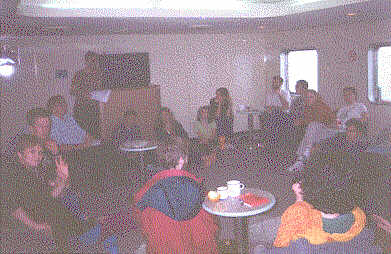
|
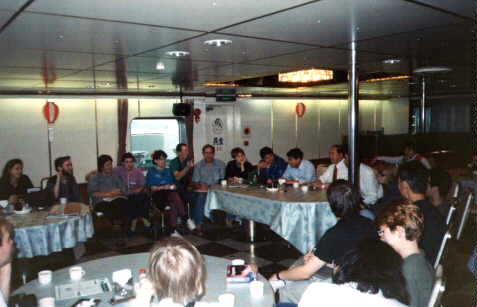
|
| A long workshop(left) discussing our strategy for the Convention. Right: a meeting with the ship's captain after breakfast | |
 |